Assessment of Irrigation Demands Based on Soil Moisture Deficits Using a Satellite-Based Hydrological Model
Abstract
1. Introduction
2. Materials and Methods
2.1. Study Area
2.2. Data Used
2.3. Description of NHM-I Model
2.4. Development of Water Demand Module for NHM-I
else D1 = (a × FC × d) − SM2
else D2 = 50 − WL2
2.5. Preparation of Input Data
3. Results
3.1. Paddy and Irrigated Dry Crops Area for Each Cell
3.2. Temporal and Spatial Variation of Irrigation Demand in the Cell
3.3. Kharif and Rabi Irrigation Demands
4. Discussion
5. Conclusions
Author Contributions
Funding
Data Availability Statement
Acknowledgments
Conflicts of Interest
References
- De-Wrachien, D.; Schultz, B.; Goli, M.B. Impacts of population growth and climate change on food production and irrigation and drainage needs: A world-wide view. Irrig. Drain. 2021, 70, 981–995. [Google Scholar] [CrossRef]
- Nazemi, A.; Wheater, H.S. On inclusion of water resource management in Earth system models–Part 1: Problem definition and representation of water demand. Hydrol. Earth Syst. Sci. 2015, 19, 33–61. [Google Scholar] [CrossRef]
- Sushanth, K.; Mishra, A.; Mukhopadhyay, P.; Singh, R. Real-time streamflow forecasting in a reservoir-regulated river basin using explainable machine learning and conceptual reservoir module. Sci. Total Environ. 2023, 861, 160680. [Google Scholar] [CrossRef]
- Torres-Rua, A.F.; Ticlavilca, A.M.; Bachour, R.; McKee, M. Estimation of Surface Soil Moisture in Irrigated Lands by Assimilation of Landsat Vegetation Indices, Surface Energy Balance Products, and Relevance Vector Machines. Water 2016, 8, 167. [Google Scholar] [CrossRef]
- Zhang, D.; Zhou, G. Estimation of soil moisture from optical and thermal remote sensing: A review. Sensors 2016, 16, 1308. [Google Scholar] [CrossRef]
- Babaeian, E.; Sadeghi, M.; Jones, S.B.; Montzka, C.; Vereecken, H.; Tuller, M. Ground, proximal, and satellite remote sensing of soil moisture. Rev. Geophys. 2019, 57, 530–616. [Google Scholar] [CrossRef]
- De-Lima, R.S.; Li, K.Y.; Vain, A.; Lang, M.; Bergamo, T.F.; Kokamägi, K.; Burnside, N.G.; Ward, R.D.; Sepp, K. The Potential of Optical UAS Data for Predicting Surface Soil Moisture in a Peatland across Time and Sites. Remote Sens. 2022, 14, 2334. [Google Scholar] [CrossRef]
- Li, Z.L.; Leng, P.; Zhou, C.; Chen, K.S.; Zhou, F.C.; Shang, G.F. Soil moisture retrieval from remote sensing measurements: Current knowledge and directions for the future. Earth Sci. Rev. 2021, 218, 103673. [Google Scholar] [CrossRef]
- Choi, M.; Jacobs, J.M.; Bosch, D.D. Remote sensing observatory validation of surface soil moisture using Advanced Microwave Scanning Radiometer E, Common Land Model, and ground based data: Case study in SMEX03 Little River Region, Georgia, US. Water Resour. Res. 2008, 44, W08421. [Google Scholar] [CrossRef]
- Manfreda, S.; Brocca, L.; Moramarco, T.; Melone, F.; Sheffield, J. A physically based approach for the estimation of root-zone soil moisture from surface measurements. Hydrol. Earth Syst. Sci. 2014, 18, 1199–1212. [Google Scholar] [CrossRef]
- Stefan, V.G.; Indrio, G.; Escorihuela, M.J.; Quintana-Seguí, P.; Villar, J.M. High-Resolution SMAP-Derived Root-Zone Soil Moisture Using an Exponential Filter Model Calibrated per Land Cover Type. Remote Sens. 2021, 13, 1112. [Google Scholar] [CrossRef]
- Zhuo, L.; Han, D. The relevance of soil moisture by remote sensing and hydrological modelling. Procedia Eng. 2016, 154, 1368–1375. [Google Scholar] [CrossRef]
- Jung, G.; Wagner, S.; Kunstmann, H. Joint climate–hydrology modelling: An impact study for the data-sparse environment of the Volta Basin in West Africa. Hydrol. Res. 2012, 43, 231–248. [Google Scholar] [CrossRef]
- Paul, P.K.; Kumari, N.; Panigrahi, N.; Mishra, A.; Singh, R. Implementation of cell-to-cell routing scheme in a large scale conceptual hydrological model. Environ. Model. Softw. 2018, 101, 23–33. [Google Scholar] [CrossRef]
- Gaur, S.; Bandyopadhyay, A.; Singh, R. From changing environment to changing extremes: Exploring the future streamflow and associated uncertainties through integrated modelling system. Water Resour. Manag. 2021, 35, 1889–1911. [Google Scholar] [CrossRef]
- Bathurst, J.C.; O’connell, P.E. Future of distributed modelling: The Systeme Hydrologique Europeen. Hydrol. Process. 1992, 6, 265–277. [Google Scholar] [CrossRef]
- Haddeland, I.; Lettenmaier, D.P.; Skaugen, T. Effects of irrigation on the water and energy balances of the Colorado and Mekong river basins. J. Hydrol. 2006, 324, 210–223. [Google Scholar] [CrossRef]
- Biemans, H.; Haddeland, I.; Kabat, P.; Ludwig, F.; Hutjes, R.W.A.; Heinke, J.; Von Bloh, W.; Gerten, D. Impact of reservoirs on river discharge and irrigation water supply during the 20th century. Water Resour. Res. 2011, 47, W03509. [Google Scholar] [CrossRef]
- Wu, Y.; Chen, J. Estimating irrigation water demand using an improved method and optimizing reservoir operation for water supply and hydropower generation: A case study of the Xinfengjiang reservoir in southern China. Agric. Water Manag. 2013, 116, 110–121. [Google Scholar] [CrossRef]
- Wada, Y.; Wisser, D.; Bierkens, M.P. Global modeling of withdrawal, allocation and consumptive use of surface water and groundwater resources. Earth Syst. Dyn. 2014, 5, 15–40. [Google Scholar] [CrossRef]
- Brunner, M.I.; Gurung, A.B.; Zappa, M.; Zekollari, H.; Farinotti, D.; Stähli, M. Present and future water scarcity in Switzerland: Potential for alleviation through reservoirs and lakes. Sci. Total Environ. 2019, 666, 1033–1047. [Google Scholar] [CrossRef]
- Gorguner, M.; Kavvas, M.L. Modelling impacts of future climate change on reservoir storages and irrigation water demands in a Mediterranean basin. Sci. Total Environ. 2020, 748, 141246. [Google Scholar] [CrossRef]
- Zhang, P.; Ma, W.; Hou, L.; Liu, F.; Zhang, Q. Study on the Spatial and Temporal Distribution of Irrigation Water Requirements for Major Crops in Shandong Province. Water 2022, 14, 1051. [Google Scholar] [CrossRef]
- Mainuddin, M.; Kirby, M.; Chowdhury, R.A.R.; Shah-Newaz, S.M. Spatial and temporal variations of, and the impact of climate change on, the dry season crop irrigation requirements in Bangladesh. Irrig. Sci. 2015, 33, 107–120. [Google Scholar] [CrossRef]
- Christou, A.; Dalias, P.; Neocleous, D. Spatial and temporal variations in evapotranspiration and net water requirements of typical Mediterranean crops on the island of Cyprus. J. Agric. Sci. 2017, 155, 1311–1323. [Google Scholar] [CrossRef]
- Wu, D.; Fang, S.; Li, X.; He, D.; Zhu, Y.; Yang, Z.; Xu, J.; Wu, Y. Spatial-temporal variation in irrigation water requirement for the winter wheat-summer maize rotation system since the 1980s on the North China Plain. Agric. Water Manag. 2019, 214, 78–86. [Google Scholar] [CrossRef]
- Gumma, M.K.; Thenkabail, P.S.; Teluguntla, P.; Rao, M.N.; Mohammed, I.A.; Whitbread, A.M. Mapping rice-fallow cropland areas for short-season grain legumes intensification in South Asia using MODIS 250 m time-series data. Int. J. Digit. Earth 2016, 9, 981–1003. [Google Scholar] [CrossRef]
- Kumari, N.; Srivastava, A.; Sahoo, B.; Raghuwanshi, N.S.; Bretreger, D. Identification of suitable hydrological models for streamflow assessment in the Kangsabati River Basin, India, by using different model selection scores. Nat. Resour. Res. 2021, 30, 4187–4205. [Google Scholar] [CrossRef]
- Liang, X.; Lettenmaier, D.P.; Wood, E.F.; Burges, S.J. A simple hydrologically based model of land surface water and energy fluxes for general circulation models. J. Geophys. Res. Atmos. 1994, 99, 14415–14428. [Google Scholar] [CrossRef]
- Arnold, J.G.; Srinivasan, R.; Muttiah, R.S.; Williams, J.R. Large area hydrologic modeling and assessment Part I: Model development. J. Am. Water Resour. Assoc. 1998, 34, 73–89. [Google Scholar] [CrossRef]
- Wijesekara, G.N.; Gupta, A.; Valeo, C.; Hasbani, J.G.; Qiao, Y.; Delaney, P.; Marceau, D.J. Assessing the impact of future land-use changes on hydrological processes in the Elbow River watershed in southern Alberta, Canada. J. Hydrol. 2012, 412, 220–232. [Google Scholar] [CrossRef]
- Feldman, A. Hydrologic Modeling System HEC-HMS; Technical Reference Manual; US Army Corps of Engineeres: Washington, DC, USA, 2000; Available online: https://www.hec.usace.army.mil/software/hec-hms/documentation/HEC-HMS_Technical%20Reference%20Manual_(CPD-74B).pdf (accessed on 1 December 2022).
- Sieber, J.; Purkey, D. WEAP: Water Evaluation and Planning System; User Guide; Technical Report; Stockholm Environment Institute, U.S. Center: Somerville, MA, USA, 2015; Available online: https://www.weap21.org/downloads/WEAP_User_Guide.pdf (accessed on 1 December 2022).
- Ruiz, L.; Varma, M.R.; Kumar, M.M.; Sekhar, M. Water balance modelling in a tropical watershed under deciduous forest (Mule Hole, India): Regolith matric storage buffers the groundwater recharge process. J. Hydrol. 2010, 380, 460–472. [Google Scholar] [CrossRef]
- Sekhar, M.; Ruiz, L. Groundwater flow modeling of Gundal sub-basin in Kabini river basin, India. Asian J. Water Environ. Pollut. 2004, 1, 65–77. [Google Scholar]
- Raziei, T.; Pereira, L.S. Estimation of ETo with Hargreaves–Samani and FAO-PM temperature methods for a wide range of climates in Iran. Agric. Water Manag. 2013, 121, 1–18. [Google Scholar] [CrossRef]
- Valiantzas, J.D. Temperature-and humidity-based simplified Penman’s ET0 formulae. Comparisons with temperature-based Hargreaves-Samani and other methodologies. Agric. Water Manag. 2018, 208, 326–334. [Google Scholar] [CrossRef]
- Hargreaves, G.H.; Samani, Z.A. Reference crop evapotranspiration from temperature. Appl. Eng. Agric. 1985, 1, 96–99. [Google Scholar] [CrossRef]
- Chapagain, A.K.; Hoekstra, A.Y. The blue, green and grey water footprint of rice from production and consumption perspectives. Ecol. Econ. 2011, 70, 749–758. [Google Scholar] [CrossRef]
- Paul, P.K.; Gaur, S.; Kumari, B.; Panigrahy, N.; Mishra, A.; Singh, R. Diagnosing credibility of a large-scale conceptual hydrological model in simulating streamflow. J. Hydrol. Eng. 2019, 24, 04019004. [Google Scholar] [CrossRef]
- Paul, P.K.; Zhang, Y.; Mishra, A.; Panigrahy, N.; Singh, R. Comparative Study of Two State-of-the-Art Semi-Distributed Hydrological Models. Water 2019, 11, 871. [Google Scholar] [CrossRef]
- Kumar, R.; Mishra, J.S.; Upadhyay, P.K.; Hans, H. Rice fallows in the Eastern India: Problems and prospects. Indian J. Agric. Sci. 2019, 89, 567–577. [Google Scholar] [CrossRef]
- Gumma, M.K.; Thenkabail, P.S.; Teluguntla, P.; Whitbread, A.M. Monitoring of spatiotemporal dynamics of Rabi rice fallows in south Asia using remote sensing. In Geospatial Technologies in Land Resources Mapping, Monitoring and Management; Springer: Cham, Switzerland, 2018; pp. 425–449. [Google Scholar] [CrossRef]
- Fries, A.; Silva, K.; Pucha-Cofrep, F.; Oñate-Valdivieso, F.; Ochoa-Cueva, P. Water balance and soil moisture deficit of different vegetation units under semiarid conditions in the andes of southern Ecuador. Climate 2020, 8, 30. [Google Scholar] [CrossRef]
- Khan, S.; Rasool, A.; Irshad, S.; Hafeez, M.B.; Ali, M.; Saddique, M.; Asif, M.; Hasnain, Z.; Naseem, S.; Alwahibi, M.S.; et al. Potential soil moisture deficit: A useful approach to save water with enhanced growth and productivity of wheat crop. J. Water Clim. Chang. 2021, 12, 2515–2525. [Google Scholar] [CrossRef]
- Prasanna, V. Impact of monsoon rainfall on the total foodgrain yield over India. J. Earth Syst. Sci. 2014, 123, 1129–1145. [Google Scholar] [CrossRef]
- Kumar, H.V.; Shivamurthy, M.; Lunagaria, M.M. Impact of rainfall variability and trend on rice yield in coastal Karnataka. J. Agrometeorol. 2017, 19, 286–287. [Google Scholar] [CrossRef]
- Pradhan, A.; Chandrakar, T.; Nag, S.K.; Dixit, A.; Mukherjee, S.C. Crop planning based on rainfall variability for Bastar region of Chhattisgarh, India. J. Agrometeorol. 2020, 22, 509–517. [Google Scholar] [CrossRef]
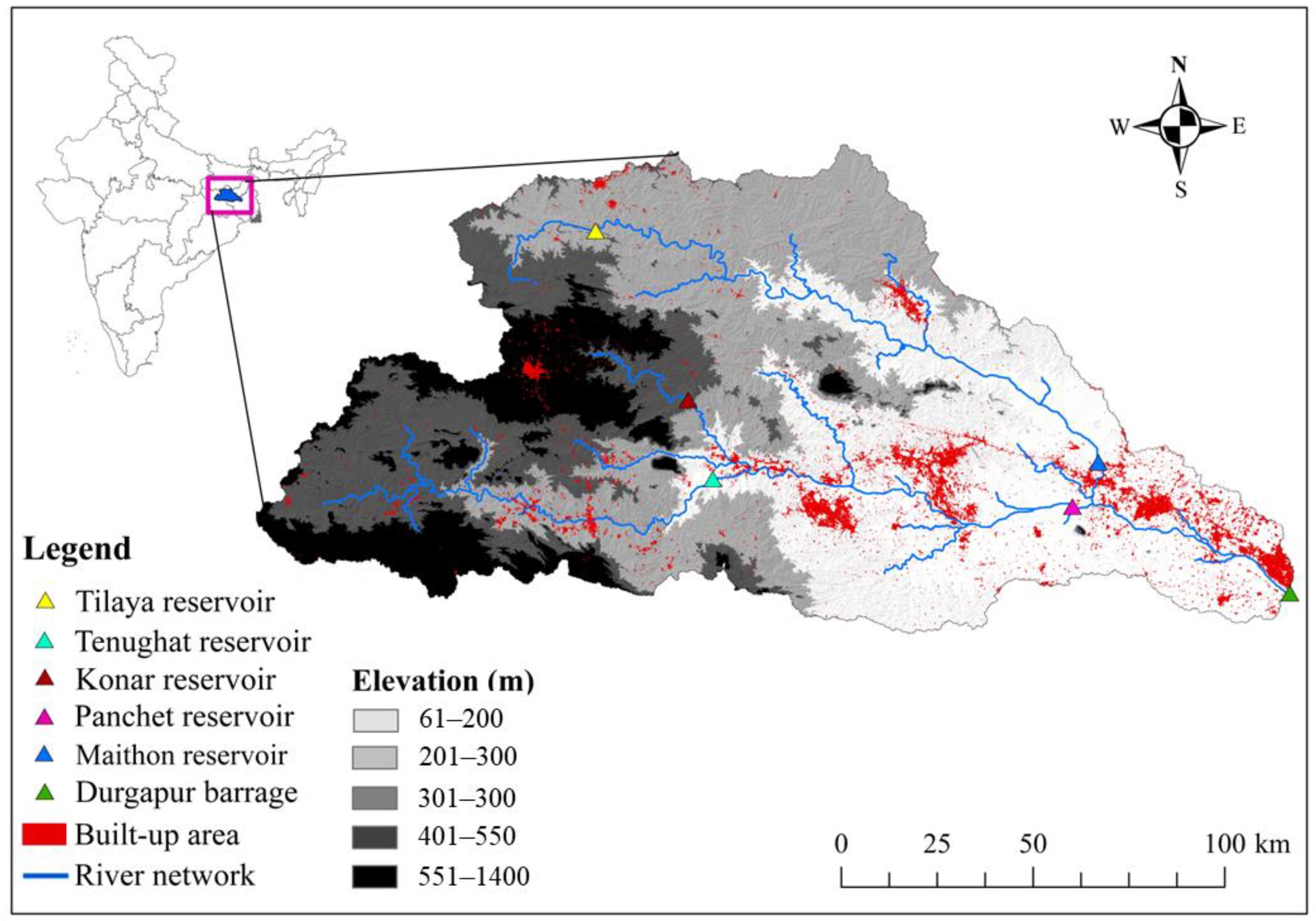
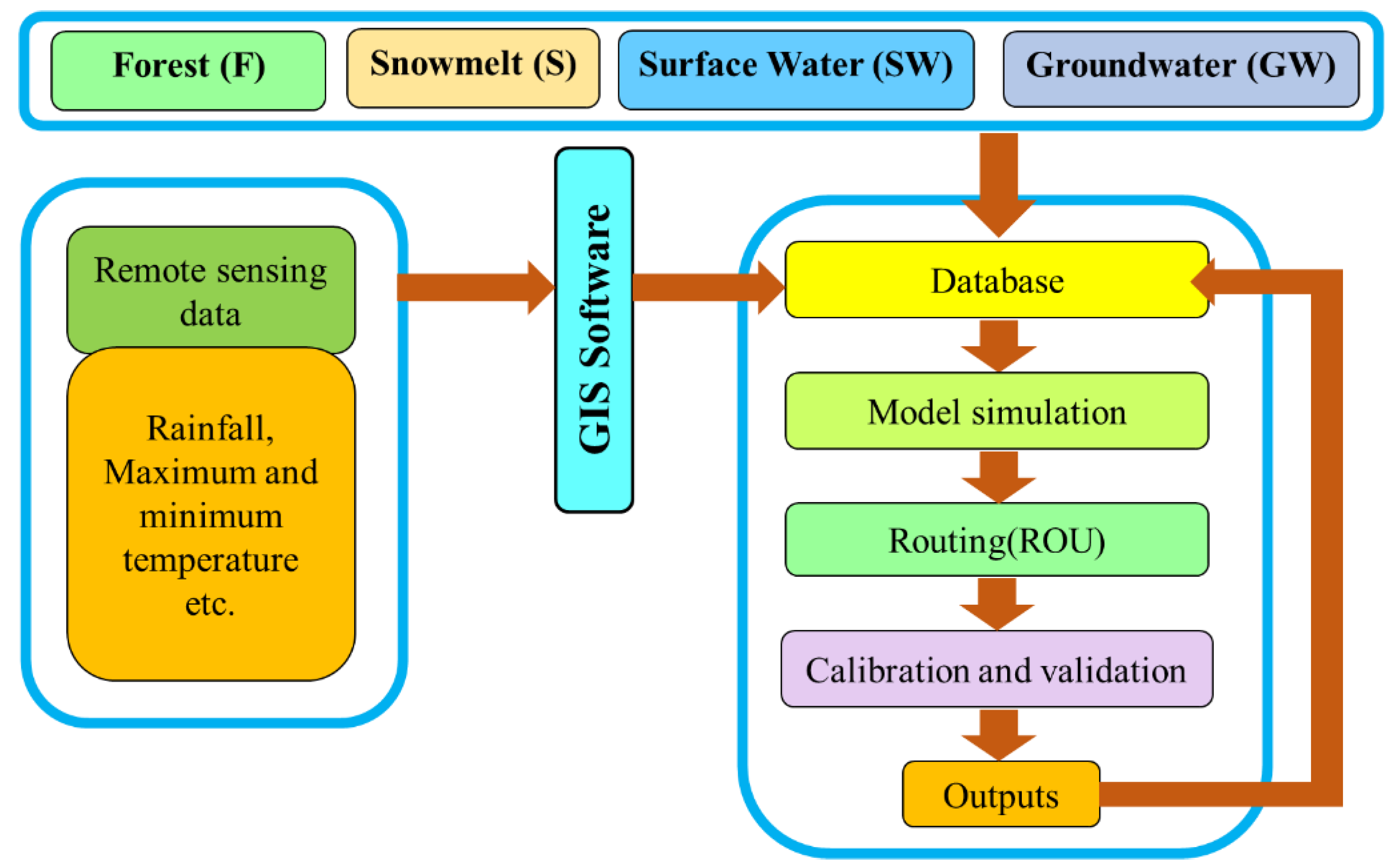
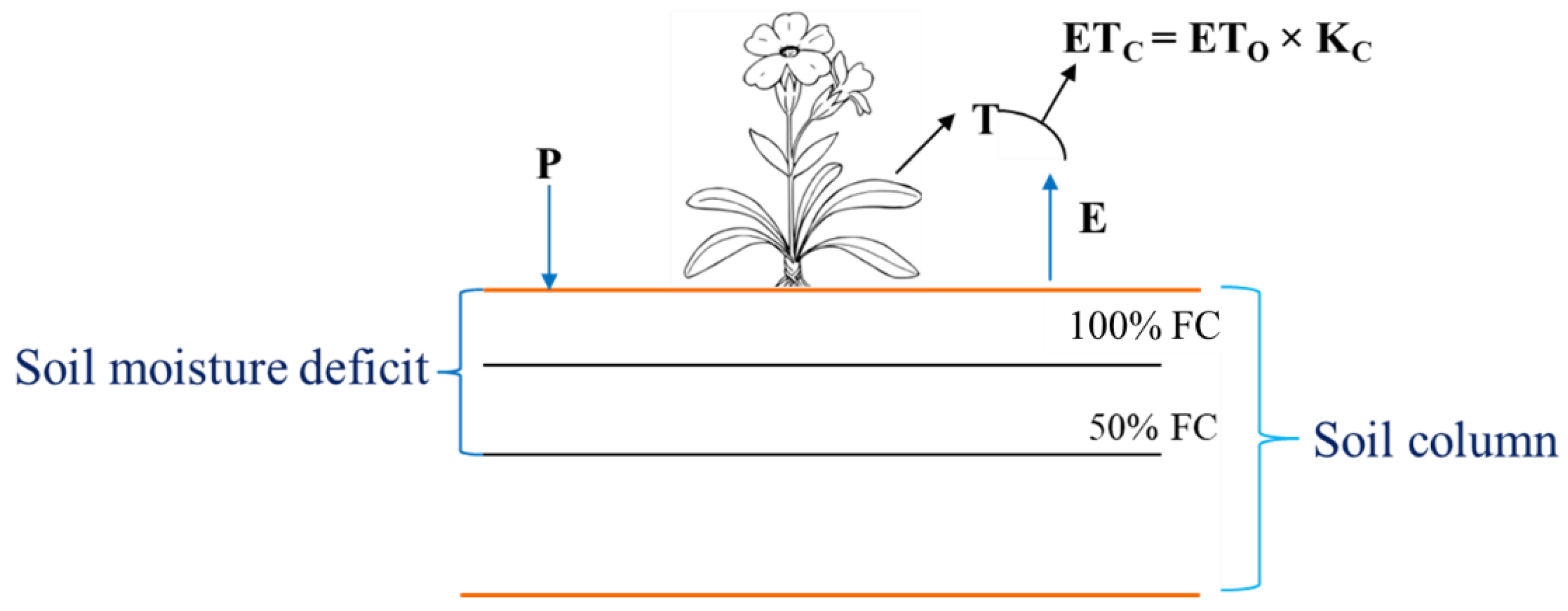

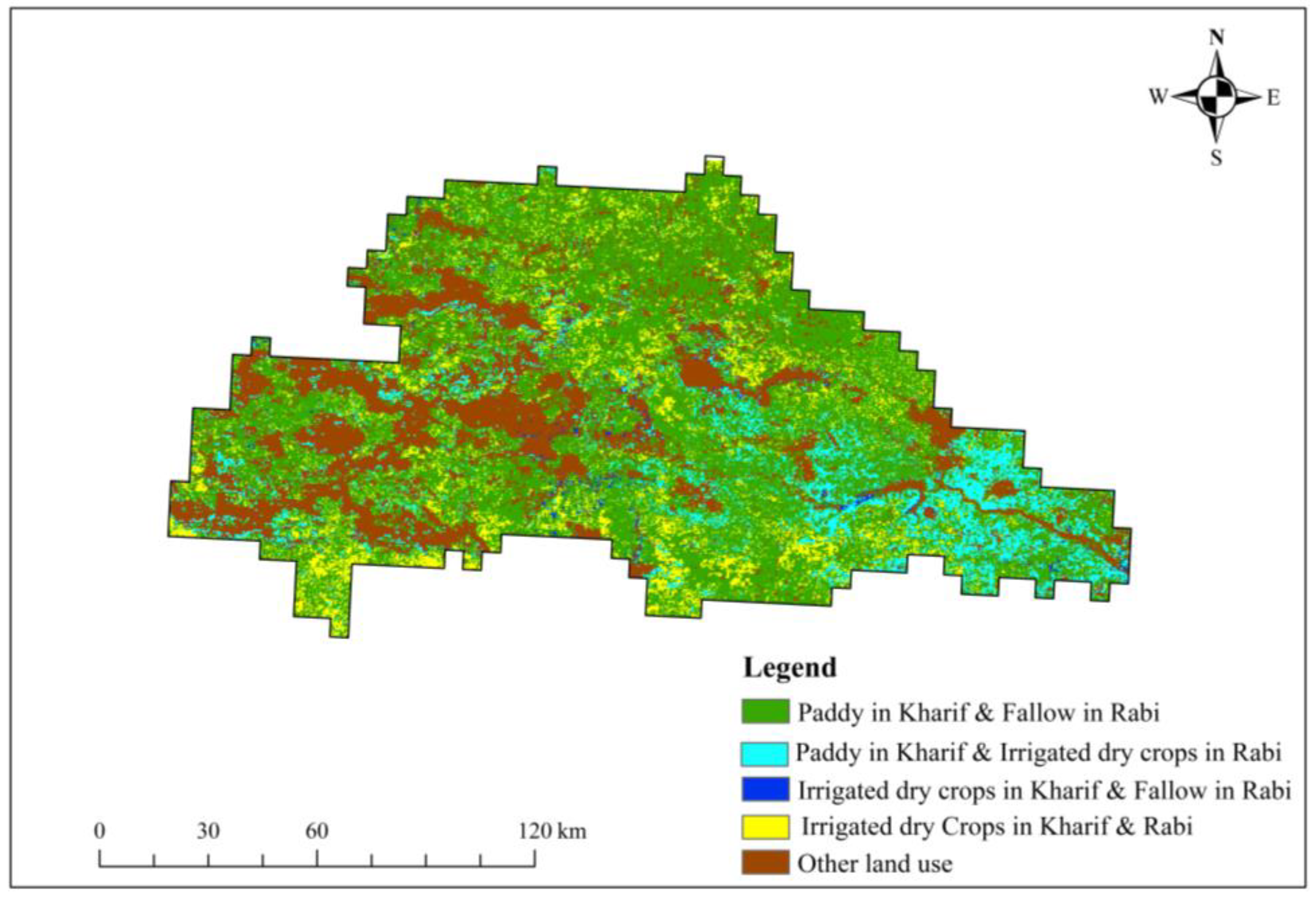



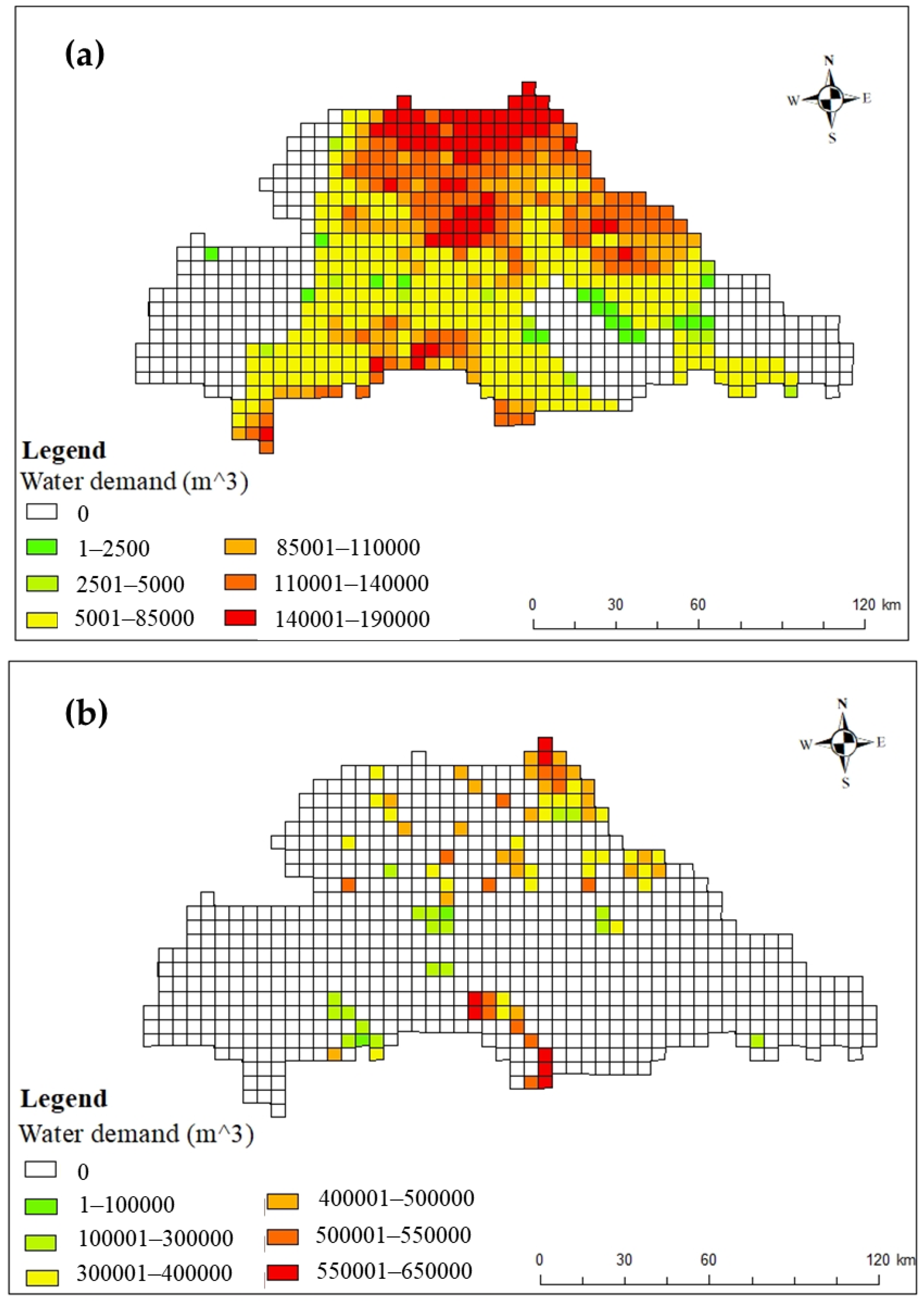
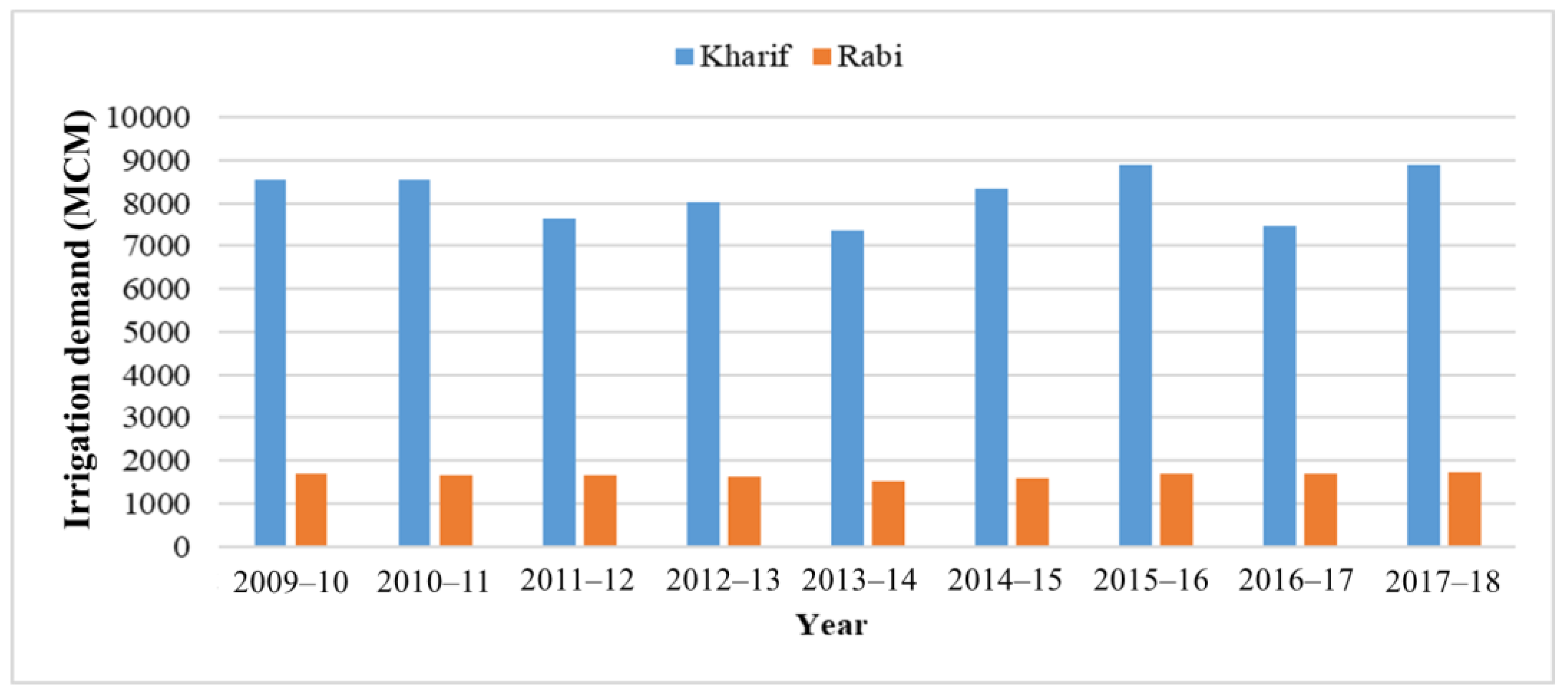
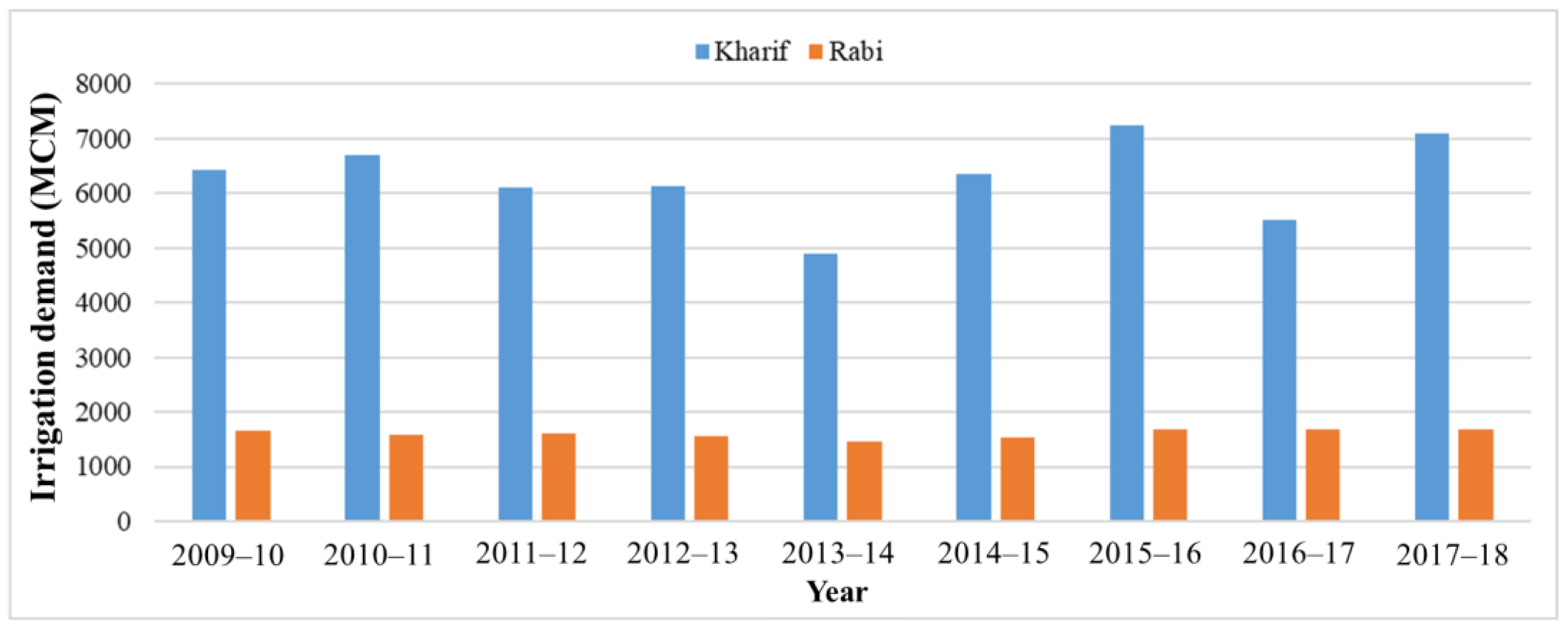
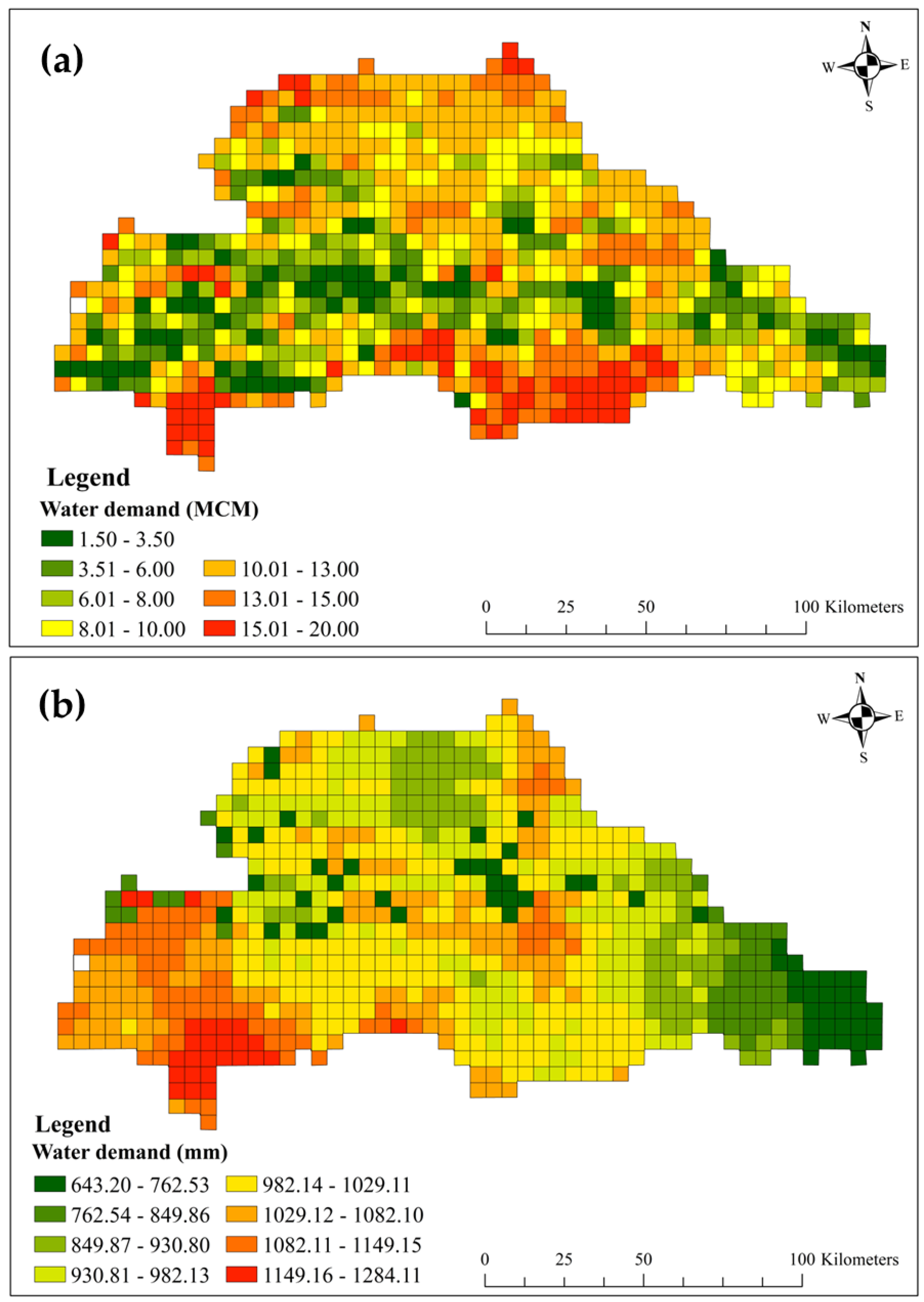
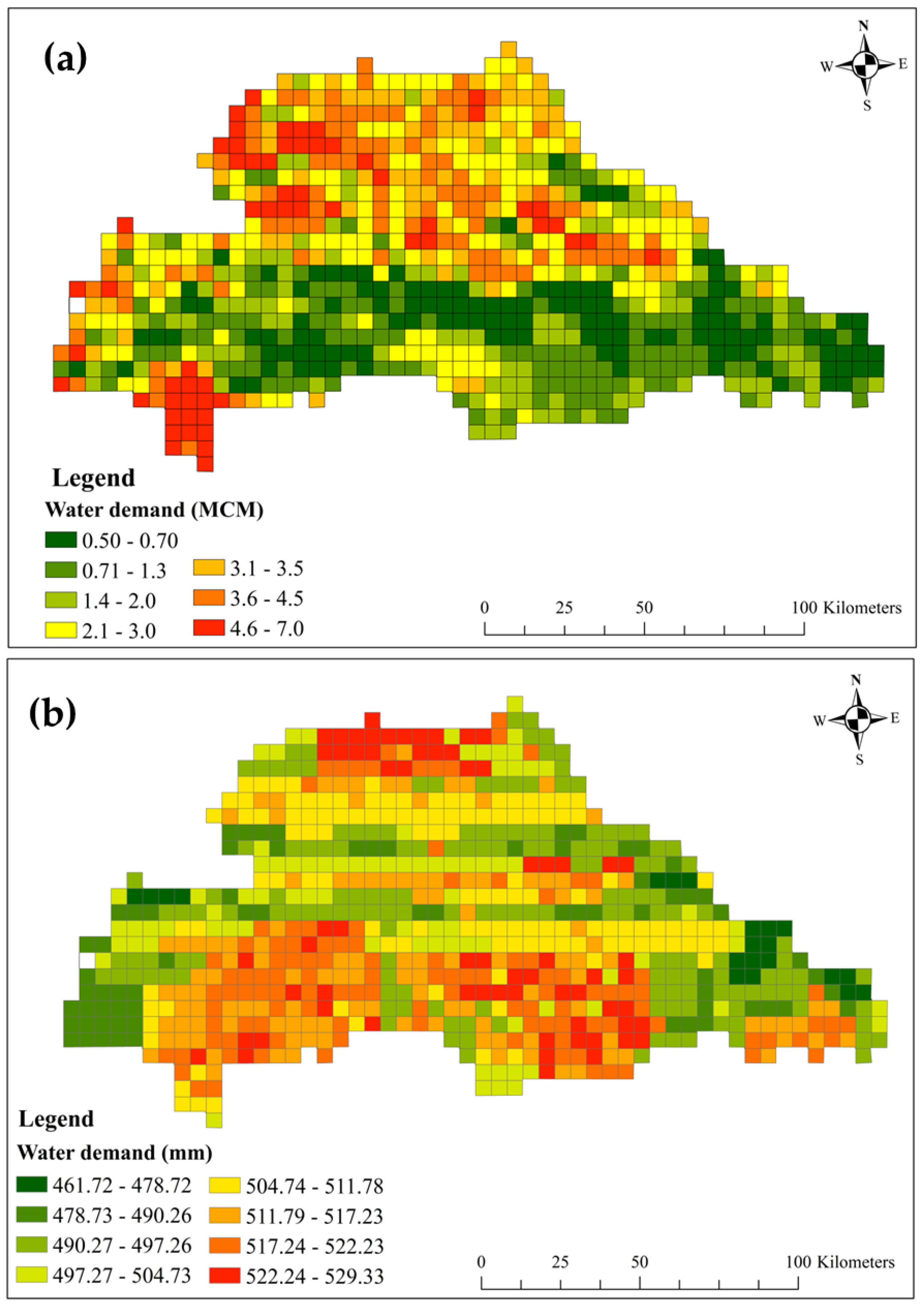
| Year | Annual Irrigation Demand (MCM) | Difference (MCM) | |
|---|---|---|---|
| AMD-0 | AMD-50 | ||
| 2009–2010 | 10,254.85 | 8086.28 | 2168.57 |
| 2010–2011 | 10,186.08 | 8269.72 | 1916.36 |
| 2011–2012 | 9302.14 | 7708.73 | 1593.41 |
| 2012–2013 | 9665.42 | 7689.89 | 1975.53 |
| 2013–2014 | 8889.03 | 6344.41 | 2544.63 |
| 2014–2015 | 9932.78 | 7871.16 | 2061.63 |
| 2015–2016 | 10,583.44 | 8923.32 | 1660.12 |
| 2016–2017 | 9147.14 | 7189.30 | 1957.84 |
| 2017–2018 | 10,596.70 | 8778.34 | 1818.36 |
Disclaimer/Publisher’s Note: The statements, opinions and data contained in all publications are solely those of the individual author(s) and contributor(s) and not of MDPI and/or the editor(s). MDPI and/or the editor(s) disclaim responsibility for any injury to people or property resulting from any ideas, methods, instructions or products referred to in the content. |
© 2023 by the authors. Licensee MDPI, Basel, Switzerland. This article is an open access article distributed under the terms and conditions of the Creative Commons Attribution (CC BY) license (https://creativecommons.org/licenses/by/4.0/).
Share and Cite
Sushanth, K.; Behera, A.; Mishra, A.; Singh, R. Assessment of Irrigation Demands Based on Soil Moisture Deficits Using a Satellite-Based Hydrological Model. Remote Sens. 2023, 15, 1119. https://doi.org/10.3390/rs15041119
Sushanth K, Behera A, Mishra A, Singh R. Assessment of Irrigation Demands Based on Soil Moisture Deficits Using a Satellite-Based Hydrological Model. Remote Sensing. 2023; 15(4):1119. https://doi.org/10.3390/rs15041119
Chicago/Turabian StyleSushanth, Kallem, Abhijit Behera, Ashok Mishra, and Rajendra Singh. 2023. "Assessment of Irrigation Demands Based on Soil Moisture Deficits Using a Satellite-Based Hydrological Model" Remote Sensing 15, no. 4: 1119. https://doi.org/10.3390/rs15041119
APA StyleSushanth, K., Behera, A., Mishra, A., & Singh, R. (2023). Assessment of Irrigation Demands Based on Soil Moisture Deficits Using a Satellite-Based Hydrological Model. Remote Sensing, 15(4), 1119. https://doi.org/10.3390/rs15041119








